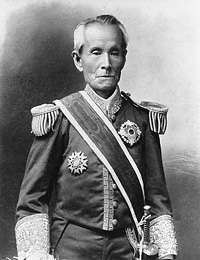Higashikuze Michitomi
Higashikuze Michitomi (東久世 通禧, January 1, 1834 – January 4, 1912) was a Japanese noble and statesman of the late Edo period and early Meiji period.
Higashikuze Michitomi | |
|---|---|
 Higashikuze, in the European-style court dress of a count and wearing his Order of the Rising Sun with Paulownia Flowers | |
| 3rd Vice Chairman of the Privy Council of Japan | |
| In office March 17, 1892 – January 4, 1912 | |
| 1st Vice President of the House of Peers | |
| In office September 13, 1869 – May 9, 1871 | |
| 2nd Chairman of the Hokkaido Development Commission | |
| In office September 13, 1869 – May 9, 1871 | |
| 1st Governor of Kanagawa Prefecture | |
| In office April 11, 1868 – November 5, 1868 | |
| Director-General of Foreign Affairs | |
| In office January 17, 1868 – January 20, 1868 | |
| Personal details | |
| Born | January 1, 1834 |
| Died | January 4, 1912 (aged 78) |
| Spouse(s) | Higashikuze Sadako (東久世 貞子) |
He was among the pro-Emperor sonnō jōi faction nobles who escaped to Chōshū Domain after members of the pro-shogunate kōbu gattai faction staged a coup in 1863. After the Meiji Restoration, he was appointed among the first Directors-General of Foreign Affairs (外国事務総督), and served the fledgling government in early negotiations. After this he continued to hold important positions, including Governor of Kanagawa Prefecture, Chairman of the Hokkaido Development Commission, and Chamberlain, culminating in roles as Vice President of the House of Peers and Vice Chairman of the Privy Council. He was a count in the Japanese peerage. His art names included Chikutei (竹亭).
Life
Higashikuze was born on January 1, 1834, in Kyoto. His father was Higashikuze Michinaru (東久世 通徳).
He served in the Imperial Court during his youth in the Bakumatsu period, participating in the sonnō jōi movement that advocated the overthrow of the shogunate and restoration of power to the emperor. However, on September 30, 1863, the pro-shōgun kōbu gattai faction took power in the court in a coup d'état. Protected by soldiers of Chōshū Domain, he escaped to Chōshū on a boat with six other court retainers. In 1864, he was moved from Chōshū to Dazaifu.
With the success of the Meiji Restoration in 1868, Higashikuze was rehabilitated. On January 17 of that year he became one of the first Directors-General of Foreign Affairs (外国事務総督), a position later replaced by that of Minister of Foreign Affairs. In this role he presided over the first foreign relations incident of the new government, the Kobe incident, in which a misunderstanding between an Imperial army and two French sailors ballooned into an occupation of central Kobe by foreign troops. On March 19 he was appointed as Director-General of the Yokohama Court, a position which was renamed twice during the half year in which he held it, first to Director-General of the Kanagawa Court and then to Governor of Kanagawa Prefecture.
On August 25, 1869, Higashikuze was appointed as the second Chairman of the Hokkaido Development Commission. As the previous chairman, Nabeshima Naomasa, had resigned before beginning his work, it was Higashikuze who began the practical operation of the office. On September 21, he set out for Hokkaido on a ship from Shinagawa, accompanied by about 200 farmers and officials of the Development Commission. He arrived at his post in Hakodate on the 25th. That October, he was granted a fief of 1,000 koku as a reward for his service in the Restoration.
On October 15, 1871, he was appointed Chamberlain of Japan. In the same year he joined the Iwakura mission on its trip around the world, broadening his horizons.
In 1882, he served as Vice President of the Genrōin, and with the institution of the Kazoku peerage system in 1884, he was granted the title of count. The hereditary status of the Higashikuze family would ordinarily have placed him as a viscount, but Michitomi's own achievements in the Meiji Restoration led him to be awarded a higher rank. Only a few other exceptions were made in this way, including Sanjō Sanetomi and Iwakura Tomomi.
In 1888 he became a member of the Privy Council, in 1890 the Vice President of the House of Peers, and in 1892 the Vice President of the Privy Council.
Sources
- 平成新修旧華族家系大成 [Collected Genealogies of Former Kazoku Nobles, Heisei New Edition] (in Japanese). 2. Kasumi Kaikan. 1996. pp. 384–385.
- "Higashikuze Michitomi". 朝日日本歴史人物事典 [Asahi Encyclopedia of Japanese Historical Figures] (in Japanese).
- "Higashikuze Michitomi". 世界大百科事典 第2版 [Heibonsha World Encyclopedia, 2nd Edition] (in Japanese).
- "Higashikuze Michitomi". デジタル版 日本人名大辞典+Plus [Big Dictionary of Japanese Names +Plus, Digital Edition] (in Japanese). Kodansha.